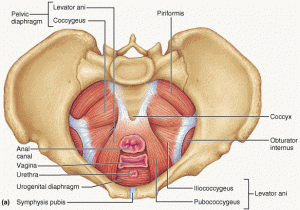 Why is it important to address Pelvic Floor Muscle Dysfunction?
Why is it important to address Pelvic Floor Muscle Dysfunction?
The “pelvic floor muscles” are a group of muscles that are arranged within the pelvis like a sling or hammock, connecting the front, back, and sides of the pelvis and sacrum. The main function of these muscles is to provide support to the organs of the pelvis, including the bladder, uterus or prostate, and rectum. They also make up part of the urethra, rectum, and vagina. These muscles must be able to effectively coordinate contraction and relaxation to allow normal functioning of the bowel and bladder. Moreover, the ability of these muscles to relax is essential to allow for normal urination, bowel movements, and sexual intercourse.
The term “Pelvic Floor Dysfunction,” or PFD, refers to these muscles when they are too relaxed or when they have too much tension. Abnormal muscle tone can affect urinary and bowel functions, sexual function, and can cause pain.
PFD may be associated with some or all of the following symptoms:
- urinary urgency, frequency, hesitancy, stopping and starting the stream of urine, painful urination, or inability to empty the bladder
- constipation, straining, pain with bowel movements
- unexplained lower back pain or pain in the pelvic region, genital area, or rectum
- pain during or after intercourse, orgasm, or sexual stimulation
- uncoordinated muscle contractions causing the pelvic floor muscles to spasm
PFD often accompanies medical conditions that involve pain in the pelvic region, such as Interstitial Cystitis, Endometriosis, Vulvodynia, and Pudendal Neuralgia.
In each of these conditions, abnormal muscle tension develops as a protective response to pain. This abnormal guarding of the pelvic floor muscles becomes a secondary source of pain and can also lead to painful intercourse. For this reason, persons with pelvic pain often are provided significant relief of symptoms by addressing the dysfunction found in the muscles of the pelvic floor.
Before appropriate physical therapy treatment may be rendered, an evaluation of the pelvic region must be performed by a physical therapist trained in pelvic rehabilitation to determine the condition of these muscles. Once the evaluation is completed, the therapist will recommend an appropriate treatment plan to address the dysfunction that is found.
Possible treatments for pelvic floor dysfunction include:
- Manual therapy: Various methods of manipulating the muscles and connective tissues in the abdomen and pelvic region are used to promote relaxation in muscles that hold tension and restore normal mobility in other tissues that are restricted.
- Modalities such as electrical stimulation, ultrasound, cold laser, ice, heat, and TENS unit application are sometimes helpful to address pain associated with chronic pelvic pain conditions.
- *Education: Instruction in self manual therapy and/or teaching a partner how to perform manual therapy to the tissues externally or internally is often very helpful for maintaining relief of symptoms.
- Stress management/relaxation techniques/deep breathing exercises: Symptoms of pelvic pain are often exacerbated by stress; therefore, stress-reducing techniques can be very helpful.
- Biofeedback is a tool that can be helpful in training the muscles to relax or can assist with strengthening exercises when appropriate.
Are” Kegels” always appropriate?
In pelvic pain conditions, it is often necessary to avoid exercises that can promote abnormal pelvic floor muscle tension. Kegel exercises, or active contraction of the pelvic floor muscles, are often NOT appropriate for pelvic pain patients, as these exercises sometimes aggravate the symptoms. The types of exercise that are appropriate can be determined by the physical therapist who assesses the muscle tone upon evaluation.
How does one know if her pelvic pain may be improved by physical therapy?
The patient must be evaluated by a physical therapist who specializes in pelvic floor muscle rehabilitation. By restoring the function of the pelvic floor muscles, symptoms may be diminished, and quality of life may be dramatically improved.
For more information, please contact:
Jennifer B. Hunt, PT
Provenance Rehabilitation
11975 Morris Rd, Suite 310A Alpharetta, GA 30005
Office: 678-819-8720 Fax: 678-819-8721
www.provenancerehab.com
